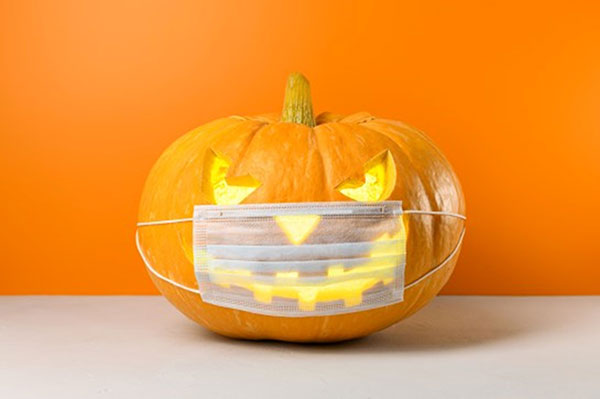Halloween Tips from Public Health—Seattle & King County

Holidays are going to be different this year, no question about it. But we all need to have some festivity, especially in the midst of all we’ve had to deal with this year. Halloween has some good celebration options since many activities can be outside and mask wearing is part of the holiday, but there are still some risks with COVID circulating.
Public Health has tips to prevent illness, help our community stay on track for reopening, and still retain some of the spooky and sweet flavor of Halloween.
First, the basics: when planning your Halloween activities, follow the fundamentals of COVID prevention. Limit close contact with other people, limit touching points, and practice good hand hygiene.
Trick-or-treating
During the pandemic, trick-or-treating presents some new challenges. Door-to-door trick-or-treating will likely bring people into close contact, especially if people gather and cluster on doorsteps and walkways. It’s also difficult to ensure that everyone is wearing the right face coverings or masks. Trunk-or-treating (when people go from car to car instead of door to door) may also be difficult to do while keeping adequate social distance. While we have continued spread of COVID-19 on our community, Public Health is encouraging other options.
If you are thinking about trick-or-treating, here are some things to consider:
- If you want to give out treats, understand the level of risk you’re willing to take. Packaged food is not considered a common source of coronavirus exposure, but it’s not without risk. If you put out a bowl of candy, a larger number of people will touch the bowl and candy. If you hand candy out individually, fewer people touch the candy, but they come into closer contact with one another, especially if children line up outside the door. It’s close contact with others that creates the greater risk of COVID spread.
- Reduce risk in how you hand out treats. Options to reduce (but not eliminate) risk include:
- Use tape to mark waiting spots six feet apart on the way up to your door.
- Use fun ways to give the candy while staying six feet apart, like slide the candy down a wrapping paper tube into their trick-or-treat bags. Or individually wrap goodie bags and line them up for families to grab and go while staying social distanced (such as at the end of a driveway or at the edge of a yard).
- When you answer the door for trick-or-treaters, wear a mask.
- Wear masks that snugly cover the nose and mouth as part of the Halloween costume. Kids can decorate cloth face coverings with fabric markers or embellishments to go with their costumes! Avoid plastic masks with holes—commercial costume masks won’t provide the same level of protection unless they are made of two or more layers of breathable fabric that fit with no gaps around the face. Make sure kids wear their masks while trick-or-treating.
- Make sure children (and adults) stay at least six feet apart from others. If you can’t keep physical distance, it’s best to avoid activities like trick-or-treating or going to a crowded pumpkin patch.
- Wash your hands thoroughly when you get home. Carry hand sanitizer so that kids can clean their hands while trick-or-treating.
- Set aside any candy that comes from outside your household for 24 hours before allowing children to handle it. Reality check: we know that it’s too much to ask of kids to wait to eat their candy. You might purchase a small amount of candy in advance so that you can have candy on hand that your kids can eat immediately on Halloween.
Safer Halloween options
We recommend Halloween activities that make it easier to maintain physical distance, wear face coverings, and keep people from sharing items. If you do have any social gathering, keep it small and on a shorter time frame (the fewer people and shorter the time, the safer it is).
Ideas for activities with lower risks of COVID-19 include:
- Organize a neighborhood costume parade with social distancing.
- Decorate yards or your neighborhood.
- Do a Halloween scavenger hunt by giving your kids lists of Halloween-themed things (like different types of decorations) to look for while they walk outdoors, keeping a distance from people outside your household.
- Hold a virtual costume party online.
- Exchange candy with families you know. Do a drop-off delivery at their doorstep for a Halloween surprise for the kids.
- Trick-or-treat inside your home by hiding candy for your kids to find. If your kids like Halloween jump scares, hide yourself, too.
- Have a spooky movie night or Halloween craft party with the family.
All ages Halloween tips
Halloween is not just a holiday for kids, so we have some key recommendations for the teen werewolves and adult ghosts and witches:
- Avoid house parties and bars, where the risk is high for the spread of COVID.
- Keep any gatherings small, outdoors when possible, or if it must be indoors, in well-ventilated spaces (open windows and doors).
- Avoid indoor haunted houses where people may be crowded together and screaming (people spray tiny droplets when they scream).
- Incorporate a mask that covers your nose and mouth snugly into your costume. Wear the mask whenever you might be in close contact with anyone outside your household.
Thank you for doing whatever you can to reduce the risk of COVID for neighbors, children, and everyone in the community. Have a happy Halloween season!
For more information, see the CDC’s Halloween celebration page.
This article originally appeared in Public Health Insider on September 23, 2020.
![AgeWise King County [logo]](https://www.agewisekingcounty.org/wp-content/themes/agewisekingcounty/images/logo.png)